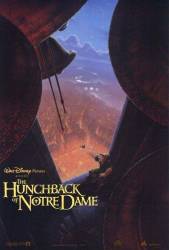Question: When Frollo, has Ezmeralda, in his grip in the the church, he says "I was just imagining a rope around that beautiful neck" and she says "i know what you were imagining", what was he thinking? I assume its something sexual, but its a cartoon.
Answer: The entire point is that he lusts after her. However, the Disney movie does not dive into that nearly as much as the novel.
Question: Is there any actual historical evidence that the Gypsies were persecuted during the time the film was set? In my study of world history I don't recall any major event when there was a mass persecution of Gypsies. Also, could this film have been set at the time when the Inquisition was at its height? This might make a lot more sense.
Chosen answer: Gypsies have been persecuted for centuries, from enforced slavery to bans on travel and immigration.
Answer: As said, they have been persecuted for centuries, especially in the Middle Ages. Frollo's anger against them is not far from what actually happened in history (you know, besides the lust).
Answer: It should also be noted there have been several instances of mass gypsy persecution throughout history. Some examples being the Holocaust, the Diet of Augsburg, and The Holy Roman Empire under Joseph I.
Question: Is the gargoyle Laverne male or female? I assumed they were are all male, but then I heard that an elder actress did the voice for Laverne.
Answer: Laverne was indeed voiced by veteran actress Mary Wickes (with Jane Withers filling in some additional dialogue after Wickes passed away during production). This would suggest that the character should be considered female rather than male, although it does also prompt the obvious question of whether gender is actually a realistic concern when talking about an animated statue.
Question: I'm not of the Catholic religion so I have a question. During Frollo's fireplace song he sees those faceless people wearing the red cloaks and then on the wall there are shadows holding crosses and stuff like that. Are these any specific objects of the catholic religion or just your average devils and angels?
Answer: They are representations of good and evil.
Question: I was wondering why of all the orders of the Roman Catholic Clergy that an Archdeacon is the main caretaker of Notre Dame. Archdeacons are a rare order of Roman Catholic Clergy even during those times. Notre Dame is a cathedral, right? So why doesn't it have its own Bishop/Archbishop/Cardinal? Where was he? I highly doubt that an Archdeacon would exercise that much authority on a Judge like Frollo thereby bypassing that of a higher order such as a Bishop who is supposed to be the central administrator of Notre Dame.
Chosen answer: From Wikipedia: "In the High Middle Ages, [the archdeacon] was the most senior diocesan position below a bishop in the Roman Catholic Church. An archdeacon is often responsible for administration within an archdeaconry...which was the principal subdivision of the diocese." As such, in the Catholic hierarchy, the functional and administrative tasks of running the cathedrals would fall to the deacons, while the bishops would govern the pastoral and liturgical functions.
Question: Why is everybody mean to Clopin?
Chosen answer: No one is mean to Clopin in the movie. But he is a gypsy and the people in Paris don't like the gypsies.
Question: What war is Phoebus returning from?
Answer: That's a good question. France actually fought no wars between the Battle of Castillon in 1451, and the Italian Wars which began in 1494. Seeing as the movie takes place in 1482 it seems strange that Phoebus would have fought in any war, unless he is at least 45 years old.






Answer: It was most certainly sexual. Frollo's whole arc was his fight against his carnal desires (seeing Esmerelda dancing in the fire, sniffing her hair, etc). In order to maintain a G-rating, they couldn't be overtly sexual, which is why it's done through suggestion and subtext.
JC Fernandez